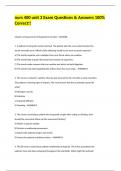Exam (elaborations)
nurs 400 unit 3 Exam Questions & Answers 100% Correct!!
Chapter 22 Assessment of Respiratory Function - ANSWER-
1. A patient is having her tonsils removed. The patient asks the nurse what function the
tonsils normally serve. Which of the following would be the most accurate response?
A) The tonsils separate your windpipe from your throat when you s...
[Show more]
Preview 4 out of 40 pages
Uploaded on
August 18, 2024
Number of pages
40
Written in
2024/2025
Type
Exam (elaborations)
Contains
Questions & answers
nurs 400 unit 3 exam questions answers 100 corr
nurs 400 unit 3 exam stuvia
chapter 22 assessment of respiratory function a
2 the nurse is caring for a patient who has just
Institution
Nurs 400
Course
Nurs 400
$14.99
Also available in package deal from $35.49
100% satisfaction guarantee
Immediately available after payment
Both online and in PDF
No strings attached
Also available in package deal (1)
$ 184.88
$ 35.49
12 items
1. Exam (elaborations) - Nurs 3100 exam 1 questions & answers 100% correct(scored a+)
2. Exam (elaborations) - Nursing 400 final exam combined study guides 100% correct!!
3. Exam (elaborations) - Nurs 400 quiz #1 final review round up!(100% correct)
4. Exam (elaborations) - Nurs 400 exams 100% correct!!
5. Exam (elaborations) - Nurs 400 unit 3 exam questions & answers 100% correct!!
6. Exam (elaborations) - Nu 400 final exam review part 1 questions & answers 100% correct (graded a+)
7. Exam (elaborations) - Nurs 328 - quiz 2 questions & answers 100% correct!!
8. Exam (elaborations) - Ppr 400 final exam review 100% correct!!
9. Exam (elaborations) - Nurs 400 final neuro&renal exam questions & answers 100% accurate!!
10. Exam (elaborations) - Nurs 400 unit 4(exam 100% accurate!!
11. Exam (elaborations) - Nurs400 pathopharm final exam study guide 100% correct!!
12. Exam (elaborations) - Nursing 400 fundamentals of nursing exams 100% correct!!
Show more
nurs 400 unit 3 Exam Questions & Answers 100%




